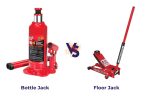When winter comes your tires will lose a lot of their grip to icy roads and freezing temperatures. There are a few ways around this, including switching out your tires for a winter set, chaining your tires, or studding them.
Studs are a good middle-ground between cheap and makeshift (chains) and expensive but reliable (winter tires).
Tire studs are small metal screws that are fitted to your tires to give them extra grip in snow and ice. You’re much better off having tire studs fitted by a mechanic but removing them is relatively straightforward.
How to Remove Studs From Tires: Quick and Easy Steps!

Step 1 – Remove your tires
Use a jack to lift your car and take the weight off the tires. Your car should come with a tire iron. Use it to remove the lug nuts and free the tire.
Step 2 – Soap and water
Using a lubricant like soapy water or store-bought tire lubricant, lubricate the studs. This makes it easier to twist the studs out as they’ll be secured in place by the force of the rubber.
Step 3 – Unscrew the studs
Here’s the tedious part. Unscrew the studs from the tires with a pair of pliers. There are around 80-100 studs per tire, so maybe put a podcast on!
Step 4 – Check for punctures
After you’ve removed the studs from the tires, you’ll need to check for any punctures in the tire. You can either submerge the tire in water and look out for air bubbles, or you can spray something like a window cleaner on each hole. If you see any bubbles, you’ve got a leak.
If your tire is all good, clean it and fill it with air.
Step 5 – Refit your tires
With all studs removed, put your tires back on. Make sure you schedule regular maintenance on them over the next few weeks to be sure none are punctured.
Do you need studded tires?
Studs are a fast and cheap way of providing your tires with extra grip during winter. If you’d prefer not to get a new set of winter tires every season, studs are the way to go.
There is still plenty of innovation happening in seasonal tires optimized for winter traction. Stud-less winter tires feature deeper treads and innovative sipe designs to minimize lateral forces when driving on ice.
Studs achieve what sipes are designed for, so whether you stud your tires is specific to your situation. There’s certainly more maintenance involved when studding tires, so be prepared to do more for investment.
How long do tire studs last?
It’s difficult to say how long studs on your tires last. It depends mostly on how you drive and in what conditions. Ice will wear the studs faster than snow, and driving studded on tires on clear road is a good way of wearing your studs down fast and getting a fine!
When should you remove your tire studs?
As soon as road conditions seem to be clearing up and winter is coming to end, you should remove your studs. Tire studs provide grip on ice and snow, but they will also damage clear, paved roads.
What are the laws on studded tires?
In the USA, only six states permit the free use of studded tires: Colorado, Kentucky, New Hampshire, New Mexico, Vermont, and Wyoming. Most other states restrict the use of studded tires to certain dates.
In Europe, you’ll find studded tires extremely popular in Scandinavia. There are varying regulations as to when and where studded tires can be used. They are completely banned in Poland and Germany, for example.










Leave a Comment